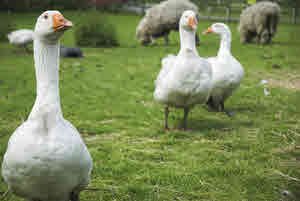 Housing Geese
Housing Geese
Geese need security but not complicated housing. They will need adequate sleeping space – about 2sqft per adult bird – and protection from damp and draughts. A strong draught free shed with a lockable door is perfect for geese to protect them from predators both animal and human.
It must be said that it is not always easy herding them inside, because they really prefer being outside, although providing grain in the house provides an incentive.
The flooring when housing geese should be covered with a layer of wood shavings, sawdust, or hemcore but avoid hay or straw bedding as this will absorb the ammonia smell of the droppings and hay can contain harmful spores that can cause respiratory infections in all poultry.
Nest boxes should be provided and these can be lined with a combination or shavings and straw and they will need to be regularly cleaned, as most geese will fowl in the nest box even when laying in them.
Where to Keep Geese (Pasture)
Geese enjoy grazing on pasture and if you have enough land they can be fed on a grass area as they will feed on the grass and the bugs, snails, slugs and worms they find while foraging. Ideally grazing for geese should be no more than 10 cm (4 in) high and consist of fresh young grasses.
If your pasture has grown long, you can put animals such as cattle or sheep onto it beforehand, and the geese can then follow on. Alternatively, you can mow it for them.
An orchard is an ideal environment for geese as they prefer the shade in midsummer and the grasses will grow lush and green under those conditions. Geese will keep the orchard trimmed and tidy and will also clear away any windfalls. Geese will however damage the trunks of young trees by stripping the new bark, so these will need wire protection.
However, most back garden keepers will not have the extensive grass areas to do this and as such a supplemental feed will be required all year round.
Stocking densities for Geese on Pasture
The amount of pasture you need will vary with the quality of grasses and climatic conditions. It is also important to distinguish between permanent breeding stock and table growers. The latter will be occupying pasture for a limited period so the stocking density will be higher than it is for breeders which are kept on a permanent basis. As a general guideline, the following are the maximum stated densities for organically raised geese, but again it must be emphasised that the nature and quality of the pasture ultimately dictate what density is suitable.
- Heavy breeding stock – 12 birds per hectare (5 per acre).
- Light breeders – 15 birds per hectare (6 per acre).
- Growers or market geese – 600 birds per hectare (250 per acre).
Keeping Geese Safe & Contained
If you want to contain geese to a certain area fencing of 1m in height will restrict them and prevent them from wandering.
This area should also be either covered or have electric fencing or fox-proof fencing around the perimeter as whilst geese can protect themselves better than smaller poultry, they are still vulnerable to Mr Fox Many people believe that a gander is capable of seeing off a fox, but I’m afraid that this is not true in practice.
Further Articles All About Geese
- Breeds of Geese & Breeding Geese
- Geese Diseases, Parasites, Worms, Lice & Mites
- Housing Geese, Pasture, and Safety
- Introduction to Geese & Feeding Geese
- Rearing Geese for the Table from Starting with Geese

